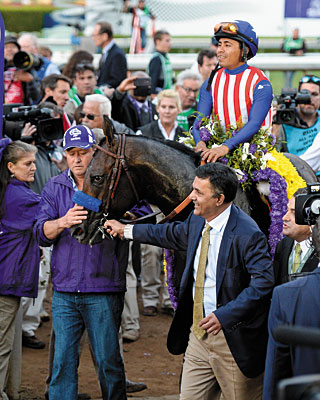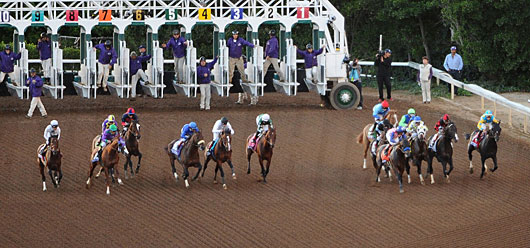In an era that many racing states have correctly moved to the standard of determining if a foul affected the outcome of a race before moving forward with a disqualification, the start of too many races has become a free-for-all.
The Breeders' Cup Classic (gr. I) served as the latest example of the problem.
Bayern should have come down for interference at the start of the Breeders' Cup Classic (gr. I). But as ridiculous as it sounds, I agree that the stewards had no way of knowing if that interference resulted in Bayern winning. If he hadn't interfered, he still MAY have won. I don't think Bayern would have won without the early interference and would have disqualified him, but I can see where stewards don't want to guess how a race outcome may or may not have changed because of an early infraction.

Breeders' Cup Classic - Photo by Crawford Ifland - Order This Photo
In fact, this is how many stewards have interpreted infractions that occur shortly after the start of the race. The result has been an unfair and unsafe situation at the start of many U.S. races.
By requiring stewards to determine if a foul affects the outcome of a race, fouls at the start of a race are rarely, if ever, called. It effectively has allowed for all manner of fouls early in a race because stewards cannot say if those fouls affect the outcome. Worse than that, the current rules effectively award horses who bump or interfere with others on their way to the lead or their desired position.
For years, most racing jurisdictions only asked stewards to determine if a horse committed a foul. A horse veering into another horse or a sustained run into the path of a rival was a foul and the horse-in-question would come down, whether that horse won by a nose or ten lengths. The stewards would watch the replay, determine if an infraction occurred, and make a decision.
But now in many states stewards first determine if an infraction occurred, then before taking action, also determine if that foul changed the race outcome. The added hurdle for a DQ was put in place to avoid punishing a five-length winner because of a minor bump in the first turn, for instance. The change was made because it seemed a bit much to disqualify an easy winner for a minor infraction. If the horse who committed the foul won by a nose or neck, then they likely would come down.
In general, I think this has been the right move.

Bayern after his Breeders' Cup Classic Win.
Photo by Anne M. Eberhardt- Order This Photo
But what should be done about instances at the start? As the current rule is written and being interpreted, I don't see how a horse can ever come down for an infraction at the start. And from what I've seen the last few years, that's what is happening.
This is why I think rules for the start of the race should not be tied to outcome. I would require any horse that comes out of its lane and bumps another horse to re-establish its running lane before moving forward. In the case of the Breeders' Cup Classic, Bayern would have had to be straightened and redirected back into his projected path or face disqualification. As it was, Bayern slammed into Shared Belief and then continued on a hard, inside angle that compromised the runners in his path.
In requiring horses who interfere with others to re-establish themselves, Shared Belief still would have been bumped, there's always going to be some of that and it's too harsh a penalty to disqualify any horse who breaks in or out and bumps another. But under this rule Bayern and jockey Martin Garcia would know that since they broke in and bumped a rival, they would first have to be moved back into the correct path before making any other move.
Garcia would be required to make a major effort to straighten out his horse. Yes, this rule would create a high early hurdle for horses who break in or out a lane and bump a horse, but that's the way it should be. This rule would punish the horse who doesn't run straight out of the gate. It would be their "bad racing luck," that they have to slow down to re-direct their path before moving on to racing. I think over time, this would reduce the number of rough starts.
Keep in mind that besides being an issue of fairness, this is also a safety issue. Horses who dramatically break inside or outside and continue on that path are creating a dangerous situation for all other competitors, equine and jockey.
I couldn't tell you the last time I've seen a horse taken down for an incident at the start of a race. If you're recalling any DQs at the start, I wonder if those disqualifications occurred before many racing jurisdictions put in the added requirement that stewards not only determine if a foul occurred but also determine if that foul affected the race outcome. Or maybe the interference at the start you're thinking of occurred in a jurisdiction where once interference is determined, a horse comes down regardless of how it may or may not have affected the outcome. Yes, racing's most basic rules differ from state to state. That's a big problem as well.
Bayern committed a foul at the start of the Breeders' Cup Classic (gr. I) but I can't tell you if it affected the outcome. I think it did, but I can't, in fact, say it did. Perhaps the top four would have been the exact same. Perhaps things would have been completely different.
But I also can't tell you what Shared Belief would have done if he hadn't been interfered with early. Perhaps he would have rallied past the top three; perhaps not.
Instead of asking stewards to determine such scenarios, new, specific rules for the start of the race are needed that are not tied to the race outcome.

Breeders' Cup Classic - Photo by Wally Skalij
Gate Placement
Not talked about as much as far as the rough start is the gate placement for the Classic at Santa Anita Park: It was pulled toward the outside fence.
This placement resulted in every horse and rider in the field looking to angle to the inside. That may have contributed, to some extent, to the roughly run start.
I'm sure the gate is placed toward the outside to prevent inside horses from drifting in once they come out of the chute, a situation that would then force them to push back to their outside to make sure they don't hit the rail. (It's the problem we see too often at the Kentucky Derby Presented by Yum! Brands [gr. I]).
Perhaps that potential problem of the inside horses outweighs the potential problem of every horse needing to angle in? I don't really have an answer for this problem, but thought it was interesting that the desired paths of every Classic runner out of the gate would be a diagonal as opposed to a straight path.




